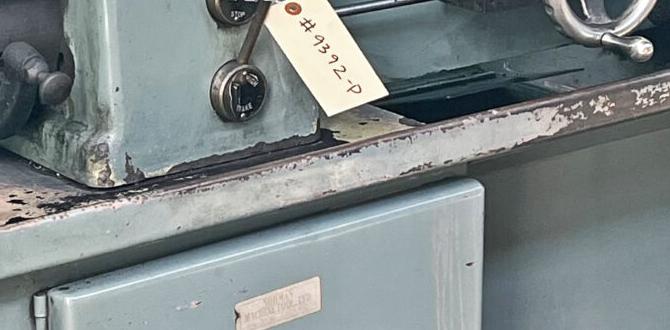Carbide end mills are the go-to solution for machining HRC60 hardened steel efficiently and with minimal chatter, offering superior performance and finish compared to traditional tooling.
Working with hardened steel, especially materials hardened to HRC60, can feel like a daunting challenge for any machinist, whether you’re just starting out or have some experience. It’s easy to get frustrated when your tools struggle, chatter, or break down quickly. But what if there was a reliable way to cut through these tough materials with confidence? That’s where the right type of tooling makes all the difference. We’re going to explore how specific carbide end mills are designed to tackle HRC60 steel, ensuring smoother cuts, longer tool life, and a great finish on your projects. Get ready to transform your approach to machining hardened steel – it’s simpler than you think!
Why HRC60 Steel is a Machining Challenge
Hardened steel, particularly when it reaches a Rockwell hardness of HRC60, presents a unique set of problems for machinists. This material has undergone a heat treatment process that significantly increases its strength and wear resistance. While this makes it ideal for applications requiring extreme durability (like gears, bearings, or tooling components), it also makes it incredibly difficult to machine. Traditional high-speed steel (HSS) tools often struggle. They can quickly dull, overheat, and even break when attempting to cut into such a hard material. This difficulty not only slows down production but can also lead to poor surface finishes and require frequent tool changes, increasing costs and downtime. The sheer hardness means that your cutting forces are higher, and the material’s tendency to resist deformation requires tools that can withstand tremendous stress and heat without losing their cutting edge.
The core issue is the balance between hardness and toughness. HRC60 steel is very hard, which means it resists scratching and wear. However, this hardness can make it brittle. When a cutting tool engages with it, the forces are concentrated. If the tool isn’t designed for this, it can chip or fracture. Furthermore, the friction generated during cutting can cause significant heat buildup. This heat can soften the cutting edge of the tool, leading to rapid wear and a loss of sharpness. For beginners, misunderstanding these properties can lead to tool breakage and damaged workpieces, creating a cycle of frustration. Choosing the right tool isn’t just about having a sharp edge; it’s about having an edge that can maintain its sharpness and integrity under extreme conditions.
The Carbide End Mill Solution for HRC60
Fortunately, advancements in tooling technology, particularly with carbide end mills, offer a robust solution for machining HRC60 steel. Carbide, specifically tungsten carbide, is an extremely hard and wear-resistant material that is ideal for cutting tough metals. When manufactured with specific geometries and coatings, carbide end mills can effectively cut through hardened steel while minimizing the problems associated with softer tooling.
What makes carbide end mills so suitable? It boils down to their material properties and design. Tungsten carbide has a very high melting point and hardness, meaning it can withstand the high temperatures and cutting forces generated when machining HRC60 steel. Unlike HSS, carbide retains its hardness at elevated temperatures, preventing the cutting edge from softening and degrading rapidly. This allows for faster cutting speeds and deeper cuts than would be possible with HSS tools. Furthermore, the brittle nature of carbide is mitigated through careful engineering of the flute design, the number of flutes, and the overall tool geometry, which helps to manage stress and prevent chipping.
When selecting a carbide end mill for HRC60 steel, look for specific features. These often include a higher number of flutes (e.g., 4 or 5 flutes) to provide better surface finish and stability, a strong core for rigidity, and often a coating designed for high-temperature applications. For instance, a PVD (Physical Vapor Deposition) coating like TiAlN (Titanium Aluminum Nitride) or AlTiN (Aluminum Titanium Nitride) can provide an extra layer of heat resistance and hardness, further extending tool life and improving performance. The geometry of the cutting edges and the helix angle also play crucial roles, engineered to shear the tough material effectively and evacuate chips efficiently to prevent re-cutting and heat buildup.
Key Features of Carbide End Mills for Hardened Steel
- Material: Made from tungsten carbide, which offers superior hardness and wear resistance compared to HSS.
- Number of Flutes: Often 4 or 5 flutes are preferred for HRC60 due to better stability and surface finish. More flutes provide better support for the cutting edge.
- Coatings: Specialized coatings like TiAlN or AlTiN are common. These enhance heat resistance, lubricity, and further increase hardness.
- End Geometry: Square end, ball nose, or corner radius designs are available, depending on the desired cut. For HRC60, a robust corner design is often beneficial to prevent chipping.
- Helix Angle: A moderate helix angle (e.g., 30-45 degrees) is often used. This provides a good balance between cutting edge strength, chip evacuation, and reducing cutting forces.
- Core Strength: A thicker core supports the cutting edges and resists bending or breaking under heavy loads.
Choosing the Right Carbide End Mill: Size and Geometry Matter
Selecting the correct carbide end mill isn’t just about grabbing any carbide tool; the size and specific geometric features are critical for success when machining HRC60 steel. For instance, a 3/16 inch carbide end mill with a 1/4 inch shank and longer reach might be your perfect tool for intricate profiling or reaching into deeper cavities in hardened steel parts. The diameter dictates the width of your cut, and the shank diameter determines the rigidity of the tool holder connection. A 1/4 inch shank on a 3/16 inch end mill often signifies a more robust tool. The “long reach” aspect is also vital for applications where you need to machine beyond the typical capacity of a standard tool length, allowing access to features without repositioning the workpiece excessively.
The geometry of the end mill’s cutting tip is equally important. A square end mill is for general-purpose slotting, profiling, and facing. A ball nose end mill is used for 3D contouring and creating fillets. A corner radius end mill offers a slight radius at the tip, which adds strength to the cutting edge, making it more resistant to chipping when taking heavier cuts in hardened materials. For HRC60 steel, using an end mill with a corner radius can significantly extend tool life by reducing stress concentrations at the corners during plunge cuts or tight inside corner machining.
When machining hardened steel, minimizing deflection is paramount. A longer reach end mill, while useful for access, can be more prone to deflection if not chosen carefully. High-performance carbide end mills designed for hardened steel often incorporate designs to combat this. These might include specific flute geometries that channel chips away efficiently, reducing the chance of them welding to the cutting edge and increasing cutting forces. A stronger core and a precise helix angle also contribute to a more stable cut, reducing vibration and chatter.
Common End Mill Geometries for Hardened Steel
- Square End Mill: Versatile for general machining.
- Ball Nose End Mill: Ideal for 3D profiling and rounded surfaces.
- Corner Radius End Mill: Adds edge strength and reduces chipping in corners.
Technical Specifications to Look For
When you’re ready to purchase an end mill for your HRC60 steel projects, paying attention to the specifications listed by the manufacturer is crucial. This is where you find the details that tell you if the tool is truly designed for your task. For example, a common keyword search might involve terms like “carbide end mill 3/16 inch 1/4 shank long reach for hardened steel HRC60 minimize deflection.” Let’s break down what those terms mean and what other specs are important.
Diameter: The 3/16 inch refers to the cutting diameter of the end mill. This is the width of the cutting surface.
Understanding Tool Coatings for Hardened Steel
The coating on a carbide end mill is not just for show; it’s a critical component that enhances performance, especially when dealing with tough-to-machine materials like HRC60 steel. These coatings are applied using processes like PVD (Physical Vapor Deposition) or CVD (Chemical Vapor Deposition) and form a microscopic layer on the cutting surface. This layer dramatically improves the cutting characteristics of the tool.
For HRC60 steel, coatings that offer excellent thermal stability and abrasion resistance are most beneficial. The two most common and effective for this application are:
- TiAlN (Titanium Aluminum Nitride): This is arguably the most popular coating for machining hardened steels. It forms a hard, wear-resistant outer layer and a thin, stable aluminum oxide layer at higher temperatures. This oxidation layer acts as a protective barrier, preventing the cutting edge from overheating and softening. TiAlN coatings are excellent at resisting abrasive wear and can significantly extend tool life. They are also beneficial in dry machining or with minimal coolant.
- AlTiN (Aluminum Titanium Nitride): Similar to TiAlN, but with a higher aluminum content, AlTiN offers even better thermal stability. This means it can withstand higher cutting temperatures, making it an excellent choice for very demanding applications where aggressive cutting parameters are used on hardened steels. The increased aluminum content allows for a thicker protective oxide layer at higher temperatures, providing superior performance and longer tool life in demanding scenarios.
Other coatings might be used, such as ZrN (Zirconium Nitride), which offers good lubricity and is less prone to built-up edge (BUE), or even multilayered coatings that combine the benefits of different materials. When selecting your carbide end mill, don’t overlook the coating; it’s a key factor in achieving successful cuts in HRC60 steel.
Machining Strategies for Success with HRC60 Steel
Machining HRC60 steel requires a strategic approach to ensure tool life, workpiece quality, and safety. It’s not just about having the right tool; it’s about how you use it. Here are some proven strategies:
1. Proper Tool Holding and Setup
A rigid setup is non-negotiable when machining hardened steel. Any play in the system will be amplified, leading to chatter, poor surface finish, and tool breakage. Ensure your collet, collet chuck, or tool holder is in excellent condition and that the end mill is seated securely and to the correct depth. A common recommendation is to have at least 2-3 times the shank diameter of the tool inserted into the tool holder for maximum rigidity. For longer reach end mills, this becomes even more critical. Using a tool holder known for high runout accuracy, such as a hydraulic or shrink-fit holder, can make a significant difference.
2. Cutting Parameters: Speed and Feed
This is where most beginners struggle. For HRC60 steel, you’ll generally use lower cutting speeds (surface feet per minute or SFM) and moderate to high feed rates compared to softer materials. The exact parameters depend heavily on the end mill’s diameter, number of flutes, coating, and your machine’s rigidity.
- Surface Speed (SFM): For carbide end mills in HRC60 steel, typical surface speeds can range from 50-150 SFM, but always consult the tool manufacturer’s recommendations. Starting at the lower end of the recommended range and increasing incrementally is a good practice.
- Feed Rate: The feed rate is often expressed as chip load (e.g., inches per tooth or mm per tooth). For hardened steel, you want to achieve a significant chip load to ensure efficient material removal and prevent rubbing, which generates heat. Chip loads can range from 0.001″ to 0.005″ per tooth or even higher for larger diameters, again consulting manufacturer specs. The goal is to have the end mill “bite” into the material rather than scrape.
- Depth of Cut (DOC) and Width of Cut (WOC): When possible, use a smaller DOC and WOC, especially when using specialized trochoidal or high-feed milling strategies. This keeps cutting forces manageable and heat generation lower. For conventional slotting, a DOC of up to 50% of the tool diameter is often possible, but for HRC60, starting much shallower (e.g., 10-25% of diameter) and observing tool performance is wise. Width of cut is also critical; avoid taking full-width slots when possible. Using a smaller WOC (e.g., 30% of diameter) and an adaptive clearing or high-efficiency milling strategy can dramatically reduce stress on the tool.
3. Coolant and Lubrication
Adequate coolant is essential for managing heat and evacuating chips. Flood coolant is often preferred for its cooling and flushing capabilities. Through-spindle coolant can be highly effective if your machine is equipped with it, delivering coolant directly to the cutting zone. If flood coolant is not an option, consider using a mist coolant system or a high-quality cutting fluid applied directly to the tool. In some cases, dry machining with a robust coating like AlTiN is possible if the machine has excellent chip evacuation and the operator closely monitors for heat buildup. However, for beginners, using coolant is generally safer and more forgiving.
4. Chip Evacuation
Poor chip evacuation is a primary cause of tool failure in hardened steel. Chips can re-cut, increasing heat and force, or they can clog flutes, leading to tool breakage. Ensure your coolant flow is sufficient to flush chips away from the cutting zone. If milling deep slots, consider peck drilling or using a plunge milling strategy with chip breaking codes programmed into your CNC. For manual milling, periodically retract the tool to clear chips.
5. Machining Strategies
Beyond basic pocketing and profiling, consider advanced milling strategies:
- Trochoidal Milling/High-Efficiency Machining (HEM): These dynamic milling strategies use a small step-over (width of cut) and a high feed rate with a large depth of cut. They maintain a constant tool engagement, creating a continuous helical flute motion. This strategy significantly reduces cutting forces, minimizes heat buildup, and dramatically increases tool life compared to conventional milling. Many CAM software packages have built-in HSM or HEM toolpath generators.
- Adaptive Clearing: Similar to HEM, this strategy maintains a consistent chip load by varying the toolpath’s radial engagement while keeping axial depth consistent. It’s excellent for roughing out pockets in hardened materials.
These strategies are particularly well-suited for materials like HRC60 because they manage the cutting edge load and heat generation more effectively, even with tools like a 3/16 inch carbide end mill for hardened steel.
Example CNC Program Snippet (Conceptual)
Here’s a conceptual snippet of what a CNC program might look like for adaptive clearing a pocket in HRC60 steel using a 3/16″ carbide end mill. This is simplified and assumes G-code programming. Always refer to your machine’s manual and CAM software output.
N1000 (POCKET ROUGHING - HRC60 STEEL)
N1010 T1 M6 (TOOL CHANGE TO T1 - 3/16" CARBIDE END MILL)
N1020 G43 H1 (TOOL LENGTH COMPENSATION)
N1030 S3000 M3 (SPINDLE ON, 3000 RPM - ASSUMES 100 SFM FOR 3/16" DIAMETER)
N1040 (ADAPTIVE CLEARING COMMENT - SMALL STEP OVER, LARGE DEPTH)
N1050 M8 (COOLANT ON)
N1060 G0 X5.0 Y5.0 (RAPID TO START POSITION)
N1070 G1 Z-0.05 F100.0 (PLUNGE TO DEPTH, SLOWER FEED FOR PLUNGE)
N1080 G1 X5.0 Y6.0 F40.0 (FEED AT 40 IPM - CALCULATED FROM CHIP LOAD)
N1090 G2 X5.5 Y6.5 I0.0 J






